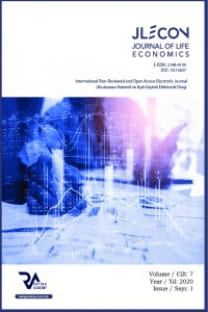THE ROLE OF OWNERSHIP ON BEHAVIOR OF DIVIDEND PAYERS
The objectives of this study are to give empirical evidences about cash cow firms and free cash flow theory. Conducting compare means paired samples t test and logistic regression with samples of 141 firms which listed in Indonesia Stock Exchange for period 2009 to 2014, this study proves dividend payers in Indonesia are not cash cows and ownership has role in determining behavior behind dividend policy. Firms with individuals and/or public ownership both for larger and smaller size shall pay dividends for some other intentions, but firms with institutional and/or state ownership concerns with its size shall pay dividends because : first, they are not at cash cows status or not under circumstance of internal conflict; second, they shall behave like cash cows in order of conflict avoidance
Anahtar Kelimeler:
Dividend Payers, Cash Cows, Free Cash Flow Theory, Ownership, Size
THE ROLE OF OWNERSHIP ON BEHAVIOR OF DIVIDEND PAYERS
The objectives of this study are to give empirical evidences about cash cow firms and free cash flow theory. Conducting compare means paired samples t test and logistic regression with samples of 141 firms which listed in Indonesia Stock Exchange for period 2009 to 2014, this study proves dividend payers in Indonesia are not cash cows and ownership has role in determining behavior behind dividend policy. Firms with individuals and/or public ownership both for larger and smaller size shall pay dividends for some other intentions, but firms with institutional and/or state ownership concerns with its size shall pay dividends because : first, they are not at cash cows status or not under circumstance of internal conflict; second, they shall behave like cash cows in order of conflict avoidance
Keywords:
Dividend Payers, Cash Cows, Free Cash Flow Theory, Ownership, Size,
___
- AIVAZIAN, V. A., GE, Y., & QIU, J. (2005). The impact of leverage on firm investment : Canadian evidence. Journal of Corporate Finance, 11, 277-291.
- BARCLAY, M. J., HOLDERNESS, C. G., & SHEEHAN, D. P. (2009). Dividends and corporate shareholders. The Review of Financial Studies, 22(6), 2423-2455.
- BRAV, A., GRAHAM, J. R., HARVEY, C. R., & MICHAELY, R. (2005). Payout policy in the 21st century. Journal of Financial Economics 77, 483-527.
- CHANG, E. C., & WONG, S. M. L. (2004). Political control and performance in China’s Listed Firms. Journal of Comparative Economics, 32, 617-636.
- COOPER, M. J., JACKSON III, W. E., & PATTERSON, G. A. (2003). Evidence of predictability in the cross-section of bank stock returns. Journal of Banking and Finance, 27, 817-850.
- DEANGELO, H., DEANGELO, L., & STULZ, R. M. (2006). Dividend Policy and the Earned/Contributed Capital Mix : A Test of the Life-Cycle Theory. Journal of Financial Economics, 81(2), 227-254.
- DECHOW, P. M. (1994). Accounting earnings and cash flows as measures of firm performance - The role of accounting accruals. Journal of Accounting and Economics, 18, 3-42.
- EASTERBROOK, F. H. (1984). Two agency-cost explanations of dividends. The American Economic Review, 74(4), 650-659.
- FAIRCHILD, R., GUNEY, Y., & THANATAWEE, Y. (2014). Corporate dividend policy in Thailand : Theory and Evidence. International Review of Financial Analysis, 31, 129- 151.
- FAULKENDER, M., & WANG, R. (2006). Corporate financial policy and the value of cash. The Journal of Finance, 61(4), 1957-1990.
- GRULLON, G., MICHAELY, R., & SWAMINATHAN, B. (2002). Are Dividend Changes a Sign of Firm Maturity? The Journal of Business, 75(3), 387-424.
- JENSEN, M. C. (1986). Agency costs of free cash flow, corporate finance, and takeover. American Economic Review, 76(2), 323-329.
- JENSEN, M. C. (1988). Takeovers : Their causes and consequences. The Journal of Economic Perspectives, 2(1), 21-48.
- KUAN, T. H., LI, C. S., & LIU, C. C. (2012). Corporate governance and cash holdings : A quantile regression approach. International Review of Economics and Finance, 24, 303-314.
- MYERS, S. C. (2001). Capital structure. The Journal of Economic Perspectives, 15(2), 81- 102.
- NEALE, B., MILSOM, T., HILLS, C., & SHARPLES, J. (1998). The hostile takeover process : a case study of Granada versus Forte. European Management Journal, 16(2), 230-241.
- ROSS, S. A., WESTERFIELD, R. W., & JAFFE, J. (2008). Corporate Finance, 8th Edition. New York, NY : The McGraw-Hill Companies, Inc.
- SHAY, J. P., & ROTHAERMEL, F. T. (1999). Dynamic competitive strategy : towards a multi-perspective conceptual framework. Long Range Planning, 32(6), 559-572.
- THAKOR, A. V., & WILSON, P. F. (1995). Capital requirements, loan renegotiation and the borrower's choice of financing source. Journal of Banking and Finance, 19, 693-711.
- WANG, H. (2011). Managerial entrenchment, equity payout and capital structure. Journal of Banking and Finance, 35, 36-50.
- Yayın Aralığı: Yılda 4 Sayı
- Başlangıç: 2014
- Yayıncı: Rating Academy
Sayıdaki Diğer Makaleler
TÜRKİYE EKONOMİSİ ÖZELİNDE PHILLIPS EĞRİSİ ANALİZİ
Çağlayan Tabar, Işın Kırışkan Çetin
CUMHURİYET İDARESİNİN MALİ KONULARDAKİ HASSASİYETİNE İLİŞKİN ZİRAAT BANKASI ÖRNEĞİ
GOVERNMENT DEBT AS A CONTRADICTORY FACTOR OF ECONOMIC GROWTH
THE ROLE OF OWNERSHIP ON BEHAVIOR OF DIVIDEND PAYERS
David Paul Elia Saerang, Winston Pontoh
Polat YÜCEKAYA, Pınar GÜROL, Karahan Kara
SYRIAN MIGRANTS IN TURKISH LABOUR MARKET
İMALAT SİSTEMLERİNDE KAYNAK KULLANIM ORANLARININ İYİLEŞTİRİLMESİ
